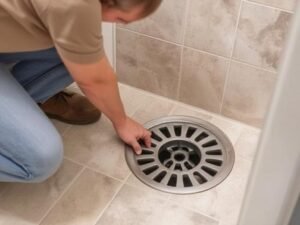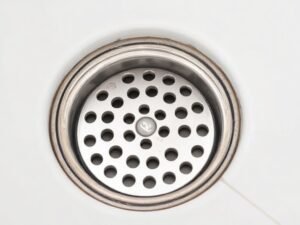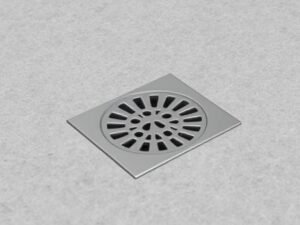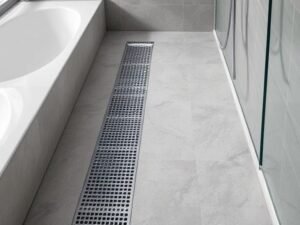Introduction
Linear shower drains have revolutionized modern bathroom design with their sleek appearance and efficient water management. Unlike traditional point drains, these elongated drainage systems offer superior water evacuation and complement contemporary bathroom aesthetics. However, even the most premium linear shower drain requires proper maintenance to function optimally and maintain its appearance.
Regular maintenance not only ensures proper water flow but also extends the lifespan of your drainage system, prevents unpleasant odors, and helps you avoid costly repairs. This comprehensive guide provides practical advice for keeping your linear shower drain clog-free and fully functional for years to come.
Understanding Linear Shower Drain Basics
What Makes Linear Drains Different
Linear shower drains differ significantly from traditional point drains in both design and function. These elongated channels typically span one side of the shower area, collecting water along their entire length. This design creates a more efficient drainage path and requires only a one-directional slope in the shower floor.
The main components of a linear shower drain include:
- The channel body (typically stainless steel, though other materials exist)
- Removable decorative grate or cover
- Hair trap or debris filter
- Waterproofing elements
- Connection to the plumbing system
Why Maintenance Matters More for Linear Drains
Linear shower drains, while aesthetically pleasing, can be more susceptible to certain maintenance issues than traditional drains. The extended channel provides more surface area for soap scum, minerals, and debris to accumulate. Additionally, many higher-end designs feature narrow openings that can trap hair and other materials more readily.
Without proper maintenance, these accumulations can lead to:
- Reduced water flow and pooling
- Unpleasant odors from bacteria growth
- Potential water damage if drainage is severely compromised
- Deterioration of the drain’s appearance
- Shortened lifespan of the drainage system

Cross-section diagram of a linear shower drain showing internal components and common areas where clogs and buildup occur.
Daily and Weekly Maintenance Routines
After Each Shower: Simple Habits That Make a Difference
Incorporating these quick habits into your post-shower routine can dramatically reduce maintenance issues:
- Quick Rinse Down: After showering, spend 10-15 seconds directing hot water specifically toward the drain to flush away soap residue and loose hair.
- Wipe the Visible Parts: Use a squeegee or microfiber cloth to quickly wipe the visible parts of the drain, removing water droplets that can lead to mineral deposits and water spots.
- Remove Visible Debris: If you notice hair or other debris collecting near the drain opening, remove it immediately rather than allowing it to wash into the drain system.
Weekly Cleaning Protocol
Once a week, perform these more thorough maintenance steps:
- Remove the Drain Cover: Most linear shower drains have removable covers or grates. Carefully lift this component using the manufacturer’s recommended method.
- Clean the Cover: Wash the cover with warm soapy water, using a soft brush to remove any buildup in the crevices and openings. For stainless steel covers, a mixture of white vinegar and water (1:1 ratio) can help restore shine and remove light mineral deposits.
- Clean the Channel: With the cover removed, clear any debris from the drain channel. Use a soft brush to clean the sides and bottom of the channel.
- Check the Hair Trap: If your drain includes a hair trap or filter, remove, empty, and clean this component according to the manufacturer’s instructions.
- Reassemble Properly: Ensure all components are thoroughly dry before reassembling to prevent corrosion, particularly with metal parts.

Step-by-step process of removing, cleaning, and reinstalling a linear shower drain cover, with hands demonstrating proper techniques for each stage.
Monthly Deep Cleaning Procedures
Removing Buildup and Preventing Odors
Once a month, perform these deeper cleaning procedures to address accumulated buildup:
- Natural Cleaning Solution: Create a mixture of baking soda and white vinegar (1/2 cup of each). Pour this solution into the drain and let it sit for 30 minutes before flushing with hot water. This natural combination helps dissolve soap scum and organic matter while deodorizing the drain.
- Channel Scrubbing: For more stubborn residue in the channel, use an old toothbrush with the baking soda/vinegar paste to gently scrub the interior surfaces.
- Connection Points: Pay special attention to the area where the drain connects to the plumbing, as this transition point often collects debris.
- Mineral Deposit Treatment: If you live in a hard water area, use a commercial calcium, lime, and rust remover specifically approved for your drain’s material. Always follow the product instructions and rinse thoroughly.
Recommended Cleaning Products
The appropriate cleaning products depend largely on your drain’s material:
- Stainless Steel Drains: Avoid chlorine bleach and abrasive cleaners. Instead, use gentle, non-abrasive stainless steel cleaners or a vinegar solution followed by olive oil for polishing.
- Brass or Copper Drains: Use specific metal cleaners designed for these materials or natural solutions like lemon juice and salt paste.
- PVC or Plastic Components: Most household cleaners are safe, but avoid acetone-based products which can damage plastic.
- Tile-In Drains: Clean the tile portion as you would your regular shower tile, using appropriate cleaners for the specific tile material.

Display of appropriate cleaning tools and products for different types of linear shower drains, labeled with their specific uses and compatible drain materials.
Professional Prevention Strategies
Installing and Maintaining Hair Guards
One of the most effective preventative measures is using a quality hair guard:
- Select the Right Type: Choose a hair guard specifically designed for linear drains, as standard circular guards won’t fit properly.
- Regular Cleaning: Remove and clean the hair guard at least weekly, or more frequently for households with multiple users or pets.
- Replacement Schedule: Even high-quality hair guards deteriorate over time. Plan to replace them every 6-12 months depending on usage.
Preventing Soap Scum and Mineral Buildup
- Consider Liquid Soap: Bar soaps tend to create more scum than liquid varieties. If soap scum is a persistent problem, consider switching to liquid shower products.
- Water Softeners: For homes in hard water areas, installing a water softener can dramatically reduce mineral buildup in all plumbing fixtures, including linear drains.
- Quarterly Preventative Treatment: Even without visible issues, perform a quarterly deep clean using enzymatic drain cleaners designed to digest organic matter before it creates blockages.
- Avoid Oils in the Shower: Bath oils, while luxurious, can solidify in drains and create stubborn clogs. If you use these products, be particularly vigilant with drain maintenance.
Troubleshooting Common Problems
Addressing Slow Drainage
If your shower is draining slowly despite regular maintenance, try these progressive solutions:
- Manual Removal: Using a flashlight, check for visible blockages that can be removed with a bent wire or specialized drain cleaning tool.
- Enzymatic Cleaners: These biological cleaners use bacteria and enzymes to break down organic matter. Pour according to package directions and typically allow 24 hours for full effectiveness.
- Plunger Method: If your linear drain design allows, use a flat-bottomed plunger to create suction and dislodge clogs. Cover any overflow outlets first.
- Manual Drain Snake: A small hand-operated drain snake (25ft or shorter) can help reach clogs further down the drainage pipe.
Eliminating Persistent Odors
Unpleasant odors often indicate biofilm buildup or trap issues:
- Biofilm Treatment: Pour boiling water down the drain, followed by 1 cup of baking soda and then 1 cup of vinegar. Cover the drain for 10 minutes, then flush with more hot water.
- Check the P-Trap: Ensure the P-trap contains water (which blocks sewer gases). In rarely used showers, the trap water may evaporate, allowing gases to rise.
- Seal Inspection: Verify that all seals around the drain are intact and not allowing gases to escape from below.
Addressing Visible Damage
For cosmetic or structural issues:
- Surface Scratches: For stainless steel covers with surface scratches, specialized stainless steel polishing products can often minimize their appearance.
- Loose Covers: Tighten any fasteners according to manufacturer specifications. Replace worn gaskets or seals.
- Cracked Components: Cracked plastic channels or damaged waterproofing typically require professional assessment and potential replacement.
When to Call a Professional
Recognizing Serious Issues
While many maintenance tasks are DIY-friendly, certain situations warrant professional intervention:
- Recurring Clogs: If your drain continues to clog despite proper maintenance, there may be deeper plumbing issues beyond the visible drain area.
- Water Backup: Water appearing elsewhere in the bathroom after using the shower indicates potential waterproofing failure.
- Structural Concerns: Visible gaps between the drain and floor, movement of the drain when stepped on, or any signs of leakage underneath require immediate professional assessment.
- Complete Blockages: If water doesn’t drain at all and basic methods don’t resolve the issue, a professional plumber can use specialized equipment to clear the blockage without damaging the system.
Choosing a Qualified Professional
When selecting a professional:
- Look for plumbers with specific experience in linear drain systems, as these differ from traditional drains
- Verify licensing and insurance
- Ask about their experience with your specific brand or type of linear drain
- Request references for similar work
- Ensure they provide warranties for both parts and labor
Cost Expectations
Professional service for linear drain maintenance typically ranges from $100-$300 depending on the complexity of the issue and your location. Complete replacement, if necessary, may cost $500-$1,500 including labor and materials.

Plumber performing professional maintenance on a linear shower drain system, showing specialized tools and proper techniques being used.
Frequently Asked Questions
Q1: How often should I thoroughly clean my linear shower drain?
Remove and clean the cover weekly, with more thorough channel cleaning monthly. Deep cleaning should occur quarterly or more frequently for heavily used showers.
Q2: Can I use chemical drain cleaners on my linear shower drain?
Most manufacturers advise against harsh chemical cleaners, especially for metal drains. They can damage finishes, deteriorate seals, and harm the environment. Enzymatic cleaners are generally safer alternatives.
Q3: Why is my linear drain still draining slowly after cleaning?
The clog may be located deeper in the plumbing system beyond the visible drain channel. Check for debris accumulation at the connection to the main drainage pipe or consider professional hydrojetting.
Q4: How do I prevent my stainless steel drain cover from discoloring?
Regular cleaning prevents discoloration. For existing discoloration, try a paste of baking soda and water, applied and gently scrubbed with a soft cloth. Always rub in the direction of the steel grain.
Q5: Is special maintenance required for heated linear drains?
Heated linear drains require all standard maintenance plus inspection of electrical connections. Always disconnect power before cleaning, and verify that all connections are dry before restoring power.
Q6: How can I tell if my linear drain has a waterproofing problem?
Signs include water stains on the ceiling below the shower, moldy odors despite cleaning, loosening tiles near the drain, or water seeping out from the shower area.
By following these maintenance guidelines, your linear shower drain will continue to provide efficient drainage and maintain its aesthetic appeal for many years. Remember that a small investment of regular maintenance time can prevent costly repairs and ensure your modern shower design remains both beautiful and functional.







